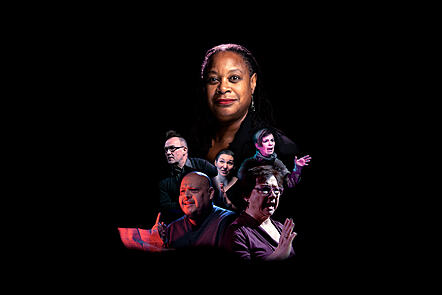Belief Systems
This video discussions how aligning belief systems can allow for people to come together to achieve great things in their careers.
Excerpt From

Transcript
0:05 we think of storytelling as beginning in 0:07 prehistoric times 0:09 when men and women sit around a fire 0:11 sharing histories 0:13 about the hunt or the ancient gods and 0:15 goddesses 0:16 but storytelling is present with us each 0:19 moment in our daily interactions 0:21 as we encounter friends and 0:22 acquaintances and try to make meanings 0:25 of events in our lives 0:26 by creating context 0:29 in some societies stories carry 0:32 histories of generations of people 0:35 or communicate societal beliefs around 0:37 creation 0:38 or the order of the universe for example 0:41 the 0:42 ancient african griot is a respected 0:45 storyteller 0:46 who travels from village to village 0:48 communicating news 0:49 as well as histories of those who 0:51 occupied the land 0:53 before his or her generation 0:56 griot's told stories of war and battle 0:59 and heroes and leaders and kings 1:02 the stories were often accompanied with 1:04 music and dancing 1:06 other ancient storytellers you may know 1:08 include 1:09 homer whose stories were recorded as the 1:12 odyssey 1:12 or the story of the ten commandments 1:14 which were written down by religious 1:16 leaders 1:18 today many stories come to us through a 1:20 variety 1:21 of mediated sources books the internet 1:26 the evening news or movies they come to 1:29 us this way rather than person to person 1:32 but however the story is communicated 1:34 the most important two elements of 1:36 storyteller 1:37 are speaker and audience 1:40 the storyteller is the person who crafts 1:43 the tale 1:44 and the audience is the intended 1:45 listener or viewer 1:48 most stories also have an antagonist and 1:51 a protagonist 1:52 who represent opposing forces 1:55 often the protagonist is the character 1:58 whose perspective is represented and is 2:00 driving the story 2:02 we tend to call these two characters the 2:04 good guy and the bad guy 2:06 but they could also be two sides of an 2:08 issue like conservatives and liberals 2:11 or two natural forces like the sun and 2:14 the moon 2:16 usually as we learn more about the 2:18 antagonist 2:19 and the protagonists we learn to 2:21 empathize with one or the other 2:24 empathy often lies with the character 2:26 whose perspective the storyteller 2:28 choose to represent and that becomes a 2:30 powerful tool for the storyteller 2:34 stories have structures beginnings 2:36 middles 2:37 and ends to carry their messages 2:39 effectively 2:41 stories can resolve or leave us hanging 2:44 sometimes they're circular repeating 2:45 themselves in a never-ending pattern 2:48 in future lessons we'll examine some of 2:50 these storytelling structures and 2:52 consider 2:52 how they shift the message we received 2:55 ultimately stories ground us in 2:57 imaginations 2:59 of who we are where we come from and why 3:02 we 3:02 exist if i can create a story in my mind 3:06 to explain my actions i feel justified 3:08 in taking that action 3:10 that's why some people think of stories 3:12 as lies because they're often used to 3:14 justify behaviors 3:16 which others may disagree with but each 3:19 side of an issue has a story 3:21 and one way to promote social change is 3:24 to listen